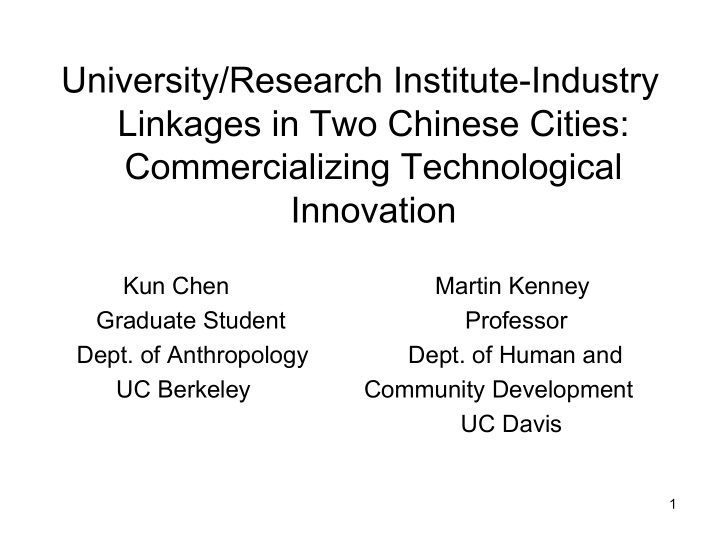



University/Research Institute-Industry Linkages in Two Chinese Cities: Commercializing Technological Innovation Kun Chen Martin Kenney Graduate Student Professor Dept. of Anthropology Dept. of Human and UC Berkeley Community Development UC Davis 1
Outline • Theoretical issues • Historical background • Current situation • Beijing and Shenzhen • Conclusion 2
Theoretical issues • Innovation system and economy • Role of universities and research institutes (URIs) • URI-industry linkages 3
Historical background • Before the 15 th century: global leader • The 15 th —1949: China’s decline and the Communist victory • 1950’s—1978:Socialist period • Since 1978: Reforms 4
Reforms • Market-oriented economy • “Open door policy” • Decentralization • Private ownership • Linkages between research and production --Torch program, high technology cluster, R&D centers 5
R&D Statistics (RMB Billion) 180 154 160 140 128.8 120 104.3 89.6 100 80 67.9 55.1 50.9 60 40.5 34.9 40 20 0 1995 1996 1997 1998 1999 2000 2001 2002 2003 Year 1995 1996 1997 1998 1999 2000 2001 2002 2003 R&D Expenditure 34.9 40.5 50.9 55.1 67.9 89.6 104.3 128.8 154 R&D/GDP (percent) 0.6 0.6 0.68 0.7 0.83 1.0 1.09 1.23 1.31 6 Note: Data compiled from the China Science and Technology Statistics Net
R&D (2003) (RMB100 million) Source: China Science and Technology Statistics Net 7
Current situation (2003) • R&D: RMB154 billion, 1.31% of GDP • 53 national high-tech zones Revenue: RMB2,094 billion (240 times than 1991) Number of high-tech companies: 32,857 (13 times) • Publication: Fifth (15 th in 1990) • Patent: Chinese patent applicants more than foreign applicants in China • Technology contracts: RMB88 billion (9 times) 8
Things Have Changed in China and No Where More than Shenzhen 1980’s 1990’s 2000’s 9 Source: Shenzhen Government Net
Beijing Shenzhen • Historical Had a history as a city for two • Became a city in 1979. background thousand years. • Served as the capital city in several dynasties. • • City’s Capital city. Special economic zone. Major • • function Political, cultural and S&T center A successful model of the of the country. economic reforms. • • Economic GDP in total is No.2 in the GDP in total is No.5 in the strength country. country. • • GDP per capita was $3074 in GDP per capita was $6510 in 2003. 2003. It remains the highest in the country. • Major industry: high-tech and • service. Major industry: high-tech and manufacturing. 10 • Affiliation with Hong Kong
Beijing Shenzhen • Center of the best URIs in the • Lack of URIs before 1990’s. S&T strength country. • Set up the virtual campus and • R&D expenditure was RMB 25 university town in late 1990’s. billion in 2003. • R&D expenditure was RMB 7 • URIs and MNC/indigenous high- billion in 2003. tech enterprises are active in R&D. • Local high-tech firms are active • R&D, publication, invention patent such as Huawei, ZTE. and technology contract value • Invention patent moved up to No.3 remain the highest in the country. in the country in 2003. • Zhongguancun Science Park • Shenzhen High-tech Industrial High-tech cluster (ZGC). Park (SHIP). 11
Beijing Shenzhen • Elite URIs in the country such as • THU, PKU, CAS started to set up URI THU, PKU, CAS. research institutes or graduate schools in the middle and late 1990’s. • URIs are concentrated in ZGC. • The virtual campus and university URI- industry town are located in SHIP. • Technology transfer activities linkages • URI-affiliated research institutes through TLO offices at URIs. serve as the bases of R&D, • URI-affiliated enterprises such as professional edu cation, and PKU’s Founder, CAS’s Lenovo, technology THU’s Tongfang. transfer/industrialization. • University science parks such as • Major mode: technology transfer THU Science Park, PKU Science and licensing through cooperation Park, BUAA Science Park. with local companies. • Major mode: spin-off and 12 university science park.
Beijing Shenzhen High-tech industrial growth URIs in other regions Traditional URIs with no URIs URIs’ spin-offs and URI-affiliated research university science parks Local high-tech enterprises institutes and virtual campus Industrialization and commercialization of Industrialization and technological innovation commercialization of technological innovation 13
Conclusion • URIs’ contribution to China’s economy – Education, research, advising government. – Technology commercialization • URI-affiliated firms • University science parks • Joint projects • Licensing • Beijing and Shenzhen with different endowments develop different strategies • Challenges 14
Recommend
More recommend